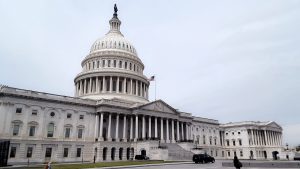This publication is based on a piece drafted for Perry World House and made possible in part by a grant from the Carnegie Corporation of New York. The views expressed are solely the author’s.
 Amidst the federal government’s struggle to contain a public health crisis as the U.S. presidential election nears, the House Select Committee on the Climate Crisis rolled out its own plan for averting catastrophe. Solving the Climate Crisis: The Congressional Action Plan for a Clean Energy Economy and Healthy, Resilient, and Just America (Climate Plan) presents a roadmap for counteracting the climate crisis by building a green economy that prioritizes workers and environmental justice. Although the Climate Plan laudably centers equity, it misses the mark when it comes to climate-induced migration. Framing climate-induced migration solely as a national security threat, the Climate Plan avers the transnational impact of U.S. carbon pollution. For those federal governments interested in climate equity, centering a global perspective that includes those displaced, especially from small island developing states (SIDS), remains critical.
Amidst the federal government’s struggle to contain a public health crisis as the U.S. presidential election nears, the House Select Committee on the Climate Crisis rolled out its own plan for averting catastrophe. Solving the Climate Crisis: The Congressional Action Plan for a Clean Energy Economy and Healthy, Resilient, and Just America (Climate Plan) presents a roadmap for counteracting the climate crisis by building a green economy that prioritizes workers and environmental justice. Although the Climate Plan laudably centers equity, it misses the mark when it comes to climate-induced migration. Framing climate-induced migration solely as a national security threat, the Climate Plan avers the transnational impact of U.S. carbon pollution. For those federal governments interested in climate equity, centering a global perspective that includes those displaced, especially from small island developing states (SIDS), remains critical.
Climate-induced migration increasingly presents the human face of the climate challenge. Climate change heightens the frequency and intensity of disasters, and disasters are increasingly driving people from their homes. Sudden-onset hazards linked to disasters displaced more people than violence and armed conflict in 2018 and 2019. More than 140 million people will be displaced within their own countries due to climate-related slow-onset events by 2050 in just three regions—Sub-Saharan Africa, Latin America, and South Asia—according to this World Bank report. Climate change interacts with a range of social, political, and economic factors to drive mobility that spans in nature from forced to voluntary, and temporary to permanent.
For small island developing states (SIDS), climate-induced migration poses a unique challenge. First, SIDS experience enhanced displacement risk. The ten countries and territories with the highest risk worldwide of annual average internal displacement per capita are all SIDS according to a United Nations Framework Convention on Climate Change report. Nearly 6% of Bahamas’ population, for example, could be displaced by hurricanes each year. Second, while the majority of people fleeing climate-related events move within their own countries, disasters can prompt cross-border climate-induced migration for SIDS because of their small land masses and economic fragility. For example, Hurricane Maria damaged or destroyed 90% of buildings in Dominica, and 20% of the population fled the island following the Category 5 hurricane.
As major emitters begin to plan for climate-induced migration, including the U.S., it is imperative that they account for migration and displacement from SIDS.
Normative Developments in International Law
Nation-states have no obligation to admit those displaced by climate-related events. There is no multilateral framework that governs climate-induced migration, and international law largely grants nation-states the right to exclude foreigners. Furthermore, international refugee law generally does not apply to people fleeing climate-related disasters. Both the lack of a governing multilateral framework and the absence of protection under international law constitutes a key protection gap for cross-border climate-induced migration.
Nevertheless, the last decade has been marked by significant normative developments. The Global Compact on Safe, Orderly and Regular Migration, the first inter-governmentally negotiated migration agreement, notably recognizes climate change as a driver of migration. Other international policy processes and legal frameworks such as the Sendai Framework for Disaster Risk Reduction and the Paris Agreement also highlight the nexus between climate change and human mobility. This recognition of climate change as a migration driver in international processes is an important step in galvanizing the global community to address climate-induced migration.
A landmark decision from the United Nations Human Rights Committee (“the Committee”) also moved the needle on legal protection earlier this year (see our blog post here). The Committee found that it is unlawful for nation-states receiving those displaced by climate-related events to return them to situations where they would be at risk of threats to life or cruel, inhuman or degrading treatment. “[W]ithout robust national and international efforts,” the Committee stated, “the effects of climate change in receiving states may expose individuals to a violation of their rights under articles 6 or 7 of the [International Covenant on Civil and Political Rights], thereby triggering the non-refoulement obligations of sending states.” The Committee further noted that climate change may undermine the right to life before “the risk of an entire country becoming submerged under water” is realized. Thus, under the Committee’s view, countries receiving climate migrants from SIDS should not to return islanders to life-threatening situations, even before climate change renders some islands completely uninhabitable. The Committee’s decision is not legally binding.
Democratic Climate Plan & Migration
Even without legal obligations, some major-emitting countries have begun to plan for climate-induced migration, and such planning should account for the particular impacts of climate-induced migration on SIDS. In the U.S., for example, the House Select Committee on the Climate Crisis includes cross-border climate-induced migration in its Climate Plan. The Climate Plan, which centers equity, presents a federal strategy for tackling climate change under a Democratic President. If the presumptive Democratic nominee, Joe Biden, were to win the 2020 presidential election, the incoming administration could take up the Climate Plan’s recommendations on climate-induced migration.
The Climate Plan recognizes that “the climate crisis amplifies geopolitical threats,” including “mass migration.” The Climate Plan also specifies that the risk emerges from developing countries. The Climate Plan notes: “Developing countries are especially ill-prepared to face the impacts of climate change. The resulting humanitarian and refugee crises, if unchecked, have the potential to become national security threats.” Thus, the Climate Plan frames climate-induced migration as a national security threat that stems from developing countries destabilized by climate change.
Because the Climate Plan positions climate-induced migration as a security issue, its recommendations focus on agencies with defense mandates, missing a key opportunity to take a global approach to equity. The Climate Plan recommends that Congress direct agencies with national defense and homeland security missions to plan for internal and cross-border climate-induced migration. Specifically, the Climate Plan recommends that Congress instruct the Department of Homeland Security to investigate and report to Congress by 2022 the implications of climate change on national security, including “preparing the homeland for internal and cross-border migration driven by climate change.” The Climate Plan also counsels for the inclusion of climate-induced migration in national security stress tests when the U.S. assesses the capacity of foreign governments. The Climate Plan’s framing fits within the increasing securitization of migration discourse.
Framing climate-induced migration as a national security threat allows the Climate Plan to incentivize humanitarian action that would allow potential migrants to stay in place. The Climate Plan notes that “[i]n poor and fragile nations… climate-driven shocks can… drive political instability and refugee movements.” Therefore, “U.S. foreign policy and aid can help to address the global humanitarian threats of climate change before they become national security threats.” Some climate-induced migration interventions rightly focus on supporting migrants in staying in place, but some migrants will want to or be forced to move. Inhabitants of SIDS, for example, whose economies and access to safe drinking water and other critical resources will slowly erode, will likely need to seek shelter in other countries unless the global community takes drastic and immediate action on climate change.
The Climate Plan purports to center equity, and there are a number of notable, and noteworthy provisions in the plan for advancing equity at the domestic level. However, a vision of equity that remains limited to the U.S. elides the global nature of climate change, and the climate-induced migration challenge. A truly equitable Climate Plan would recognize that those fleeing climate change’s adverse effects pay with their lives and homelands the price of U.S. carbon pollution. The Climate Plan should therefore enhance regular migration pathways for those fleeing climate-related disasters, especially those from SIDS. For example, the U.S. federal government might adopt any of the recommendations from the Global Compact on Safe, Orderly, and Regular Migration (after signing on) for responding to sudden- and slow-onset events, including a special visa category.
**
Climate-induced migration will largely be a challenge for national governments as they plan for increased displacement and urbanization within their own territories. Given the structure of the international legal system, however, people who flee across national borders are especially at risk. International law largely leaves admission of foreigners to the discretion of nation-states. While the impacts of climate change may trigger non-refoulement obligations, currently, federal governments largely have the power to deny climate migrants at will. However, planning makes climate-induced migration more of an opportunity for integrating climate migrants effectively into host societies, honoring their dignity, and capturing the benefits of human mobility. For those federal governments interested in equity, centering a global perspective that includes those displaced from SIDS remains critical.


